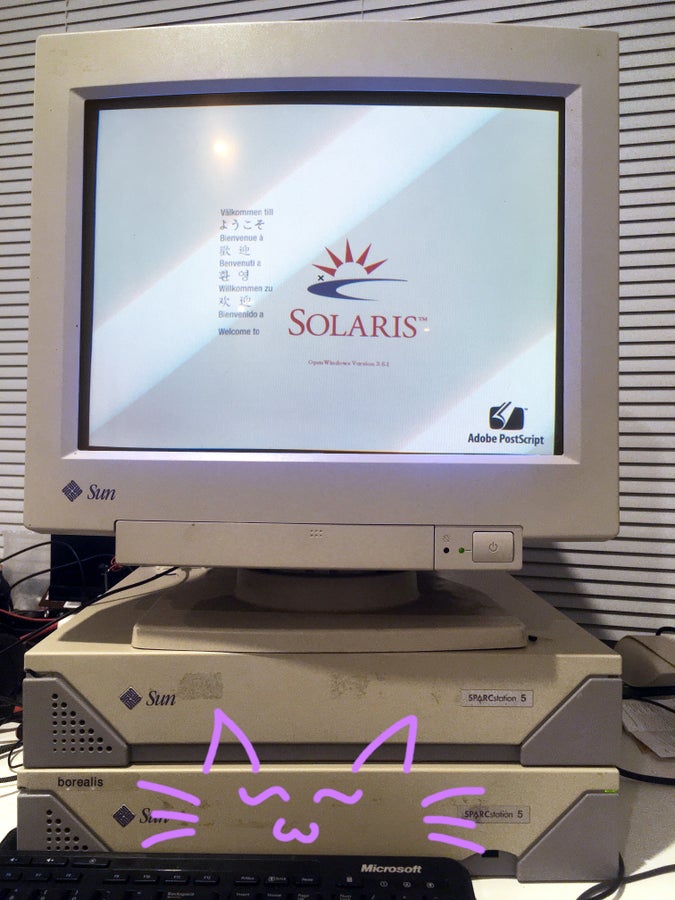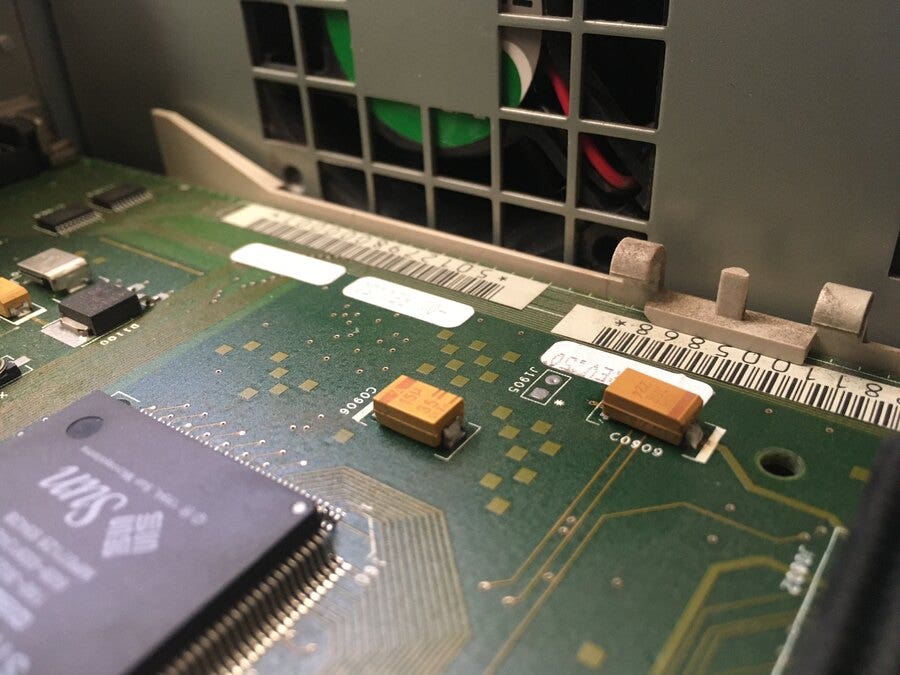sunny computers, part 3

previously, we cracked the Ultra 5’s root password, dumped all but one of the scsi drives, built a usb input adapter, and revived borealis, the older SS5 shown above with a poorly drawn cat face (hi @lethalbit). see also:
- usb3sun first irl test!
- usb3sun, a usb input adapter for sun workstations
- A large file is a regular file whose size is greater than or equal to 2 Gbyte ( 2**31 bytes). A small file is a regular file whose size is l
since then, we’ve (+n) replaced the failed cap on borealis, learned how to reprogram its idprom, installed solaris on it, connected it to the internet, ironed out a bunch of usb3sun bugs, and more!
nonocap
i installed the replacement for C0909, a tantalum cap that failed spectacularly but wasn’t actually load bearing. i decided to use lead-free solder for the first time (ty nathaniel), but it nonetheless went smoothly.


idprom
unsurprisingly, the nvram battery is dead, so the machine forgets the date and time along with idprom details like the default mac address when powered down for long enough. this yields a default mac address of 00:00:00:00:00:00 in solaris, which won’t work, so you’ll need to either set one after the fact…
$ ifconfig le0 ether 08:00:20:xx:xx:xx
…or program the idprom by hand, one octet at a time, which is so tedious that i’ve added a macro feature (not yet released) to usb3sun to automate that:
https://twitter.com/dazabani/status/1612487561964064768
note that the demo above had a bug where the macro player skipped the important line that actually updates the checksum. less importantly, note that the hostid i used there was essentially arbitrary, because i don’t know where to find the original.
compat
in theory, the SS5 can run anything up to and including solaris 9, but the installer refuses to boot with only 64 MiB of memory. solaris 8 seemed to install, but then it took forever to fail to boot, so i ultimately settled on solaris 7.
the install went ok, and i was able to log in, but at first i struggled to get anywhere beyond that. it was like almost all of my clicks were being ignored, menus would open and never close, and moving the mouse would constantly select text.
usb3sun
turns out my input adapter had been inverting the mouse button states this whole time. when moving the mouse, we would send updates with all of the buttons “pressed”, and the buttons were only ever “released” while pressing them.
this took me days to figure out, because the guide i had been using as a protocol reference incorrectly said that the button bits are 1 when pressed and 0 when released. eventually i started doubting the axioms of my reality and found the Mouse Systems Optical Mouse Technical Reference Manual, which clearly states “(0 means depressed)”.
playing with the adapter under solaris helped me find a fix for that, a fix for the power key pin mode, a fix for the mouse baud rate, a fix to better comply with the sparc keyboard spec around idle commands, a fix for the erroneous click sound when releasing a key, a fix for the bell sound being mostly silent, and a fix for the led indicator parsing.
i also fixed the backslash key on most of my keyboards, because usb hid has separate codes for Keyboard \ and | and Keyboard Non-US \ and | (the keyboard i used to write the keymap had the latter). i wonder if this is somehow related to iso 646, which allows “national variants” to localise ascii by replacing #$@[\]{|} with more relevant characters.
usb3sun 1.0 includes all of that, plus detailed instructions for building your own prototype adapter! check out this demo to see what it can do:
https://www.youtube.com/watch?v=jpe8N0bX2XU
solaris 7
CDE is the newer of the two desktop environments you can log in with under solaris 7, the other being OpenWindows. i like how the widgets haven’t yet succumbed to the flat design trend that is so insufferable nowadays.
OpenWindows applications can also run pretty nicely under CDE, and i like the attention paid by those to the keyboard UX. for example, you can tab your focus onto the grip between panes to resize them, and buttons can be grouped together in the tab order to make them easier to skip.

the rest of this section is dedicated to the solaris 7 web browsing experience. that’s not a very fair or representative topic, just what i felt like writing about this time.
on the web
the SPARCstation 5 has onboard twisted pair ethernet, so you won’t need an aui transceiver like you would with the SPARCstation IPC. since solaris 7 uses static ip config by default, i needed to add a default route to reach the internet:
$ route add default 192.0.2.1
hotjava 1.0.2 is the default web browser. it has no support for css, nor does it support ssl, at least in the international version. as a result, it completely fails acid1, and is incompatible with ssl compatibility proxies like oldssl-proxy.

netscape communicator 4.51 can also be installed from a separate cd, but netscape 4.7 might just be the latest and greatest browser you can easily run on solaris 7.
installation was a little tricky, since solaris 7 doesn’t come with gzip. i wasn’t able to figure out how to install it either, so i premasticated the tarball on another machine:
$ gunzip -k communicator-v47-us.sparc-sun-solaris2.5.1.tar.gz
$ tar xf communicator-v47-us.sparc-sun-solaris2.5.1.tar.gz
$ cd communicator-v47-us.sparc-sun-solaris2.5.1
$ zcat netscape-v47.nif > ../netscape-4.7-solaris2.5.1.tar
but netscape refused to actually run unless i disabled X11 host access control, a common problem when running netscape as root (yeah yeah, i know).

apparently netscape 4 has a bug in the way it modifies $HOME to remove trailing slashes, turning the root user’s home directory of / into an empty string. this interacts poorly with the way libXau(?) in solaris 7 constructs the path to ~/.Xauthority:
- if
$XAUTHORITYis present, just use that - otherwise, take
$HOME, which is now\0\0 - if
result[1] != '\0'(false in this case), append"/" - append
".Xauthority", yielding uhh….Xauthority\0
step 3 was presumably intended to avoid adding a second slash when $HOME is /\0, but the code also avoids adding a slash when $HOME is \0\0, yielding .Xauthority\0, which is relative to the working directory. to be fair, that’s Not Even Wrong, depending on your interpretation of an empty $HOME.
a better workaround for running netscape 4 as root on solaris would probably be
$ env HOME=/. /path/to/netscape
netscape 4.7 supports some css, but that support was still no match for acid1.

it also supports javascript 1.3, some pre-standard DOM interfaces like document.forms and document.images, as well as the netscape-only document.layers. alert() seems to be non-blocking if you call it in a loop, which i think is a bug.
screenshots
i took these screenshots with OW Snapshot, OW being OpenWindows. by default, screenshots are saved in Sun Raster format, but with the .rs extension.


to get the screenshots off the machine, i used ftp. this was daunting at first, because setting up an ftp server can often be annoying, but it was easy with pyftpdlib:
$ cd $(mktemp -d)
$ python3 -m venv .venv
$ . .venv/bin/activate
$ pip install pyftpdlib
$ mkdir upload
$ python3 -m pyftpdlib --directory=upload --port=2121 --write
next steps
borealis has a 70 MHz cpu and its original hard drive, so it’s pretty slow. it would be fun to compare the performance with my newer SS5, which has the 85 MHz option (and a TurboGX gpu instead of a CG6).
it would also be nice to max them both out with 160 MHz upgrade kits and 256 MiB of memory someday, but their most pressing needs are probably nvram replacement and scsi emulation. who knows, maybe i’ll even try an nvram battery mod!